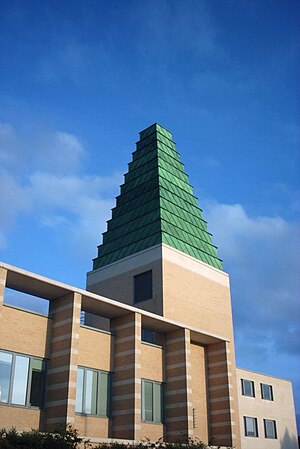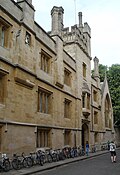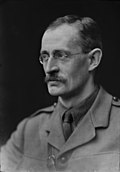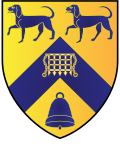| Main page | Indices | Projects |
The University of Oxford portal
The University of Oxford is a collegiate research university in Oxford, England. There is evidence of teaching as early as 1096, making it the oldest university in the English-speaking world and the world's second-oldest university in continuous operation. It grew rapidly from 1167, when Henry II banned English students from attending the University of Paris. After disputes between students and Oxford townsfolk in 1209, some academics fled north-east to Cambridge where they established what became the University of Cambridge. The two English ancient universities share many common features and are jointly referred to as Oxbridge.
The University of Oxford is made up of thirty-nine semi-autonomous constituent colleges, four permanent private halls, and a range of academic departments which are organised into four divisions. Each college is a self-governing institution within the university, controlling its own membership and having its own internal structure and activities. All students are members of a college. It does not have a main campus, and its buildings and facilities are scattered throughout the city centre. Undergraduate teaching at Oxford consists of lectures, small-group tutorials at the colleges and halls, seminars, laboratory work and occasionally further tutorials provided by the central university faculties and departments. Postgraduate teaching is provided in a predominantly centralised fashion.
Oxford operates the Ashmolean Museum, the world's oldest university museum; Oxford University Press, the largest university press in the world; and the largest academic library system nationwide. In the fiscal year ending 31 July 2023, the university had a total consolidated income of £2.92 billion, of which £789 million was from research grants and contracts.
Oxford has educated a wide range of notable alumni, including 30 prime ministers of the United Kingdom and many heads of state and government around the world. 73 Nobel Prize laureates, 4 Fields Medalists, and 6 Turing Award winners have matriculated, worked, or held visiting fellowships at the University of Oxford, while its alumni have won 160 Olympic medals. Oxford is the home of numerous scholarships, including the Rhodes Scholarship, one of the oldest international graduate scholarship programmes. (Full article...)
Selected article
The main buildings of Jesus College are located in the centre of Oxford between Turl Street, Ship Street, Cornmarket and Market Street. Jesus College was founded in 1571 by Queen Elizabeth I, upon the petition of a Welsh clergyman, Hugh Price. The foundation charter gave to the college the land and buildings of White Hall, a defunct academic hall, to which new buildings were added. The first quadrangle, which included the hall, chapel, and principal's lodgings, was completed between 1621 and 1630; it has been described as "small and pretty" and possessing "a curious charm". Construction of the second quadrangle began in the 1630s and was completed in about 1712. Further buildings were erected in a third quadrangle during the 20th century, including science laboratories, a new library, and additional accommodation. The chapel was extensively altered in 1864; one historian of the college described the work as "ill-considered". The Fellows' Library, restored in 2007, contains 11,000 antiquarian books. A project to build new student and teaching rooms opposite the college was completed in 2010. Eleven parts of the college are listed buildings. (Full article...)
Selected biography
William Beach Thomas (1868–1957) was a British author and journalist known for his work as a war correspondent and his writings about nature and country life. The son of a rural clergyman, he won an exhibition to Christ Church, Oxford, became president of the Oxford University Athletics Club. Finding work as a schoolmaster unpleasant, he turned his attention to writing articles for newspapers and periodicals, and began to write books. During the early part of the First World War Beach Thomas defied military authorities to report news stories from the Western Front. As a result he was briefly imprisoned before being granted official accreditation as a war correspondent. His reportage for the remainder of the war received national recognition, despite being criticised by some and parodied by soldiers. Beach Thomas's primary interest as an adult was in rural matters. He was conservative in his views, and feared that the post–Second World War socialist governments regarded the countryside only from an economic perspective. He was an advocate for the creation of national parks in England and Wales, and mourned the decline of traditional village society. (Full article...)
Selected college or hall
Lady Margaret Hall (generally known as "LMH") was established in 1878 and was the first college for women at the university. It began to admit men as students in 1979, and was the first of the women's colleges (along with St Anne's) to become a mixed-sex institution. The college, set in spacious grounds in Norham Gardens to the north of the city centre, is named after Lady Margaret Beaufort, mother of King Henry VII and a renowned patron of learning. Its first principal was Elizabeth Wordsworth, the great-niece of the poet William Wordsworth. Giles Gilbert Scott, famous for designing Liverpool Cathedral and the K2 red telephone box, designed the college's Byzantine-style chapel. There are approximately 600 undergraduate and postgraduate students; former students include the former prime minister of Pakistan Benazir Bhutto, the writer Antonia Fraser, the former director general of MI5 Eliza Manningham-Buller, and the actor Samuel West. LMH's motto is "Souvent me Souviens", an Old French phrase meaning "I remember often". (Full article...)
Selected image

Did you know
Articles from Wikipedia's "Did You Know" archives about the university and people associated with it:
- ... that the members of the Council of Keble College, Oxford (council member Henry Herbert, 4th Earl of Carnarvon pictured) had power to move the college away from Oxford?
- ... that British lawyer and activist of the Indian independence movement Eardley Norton was instrumental in establishing an UK-chapter of the Indian National Congress?
- ... that in 1996, the University of Glasgow renamed its Chair of Drama after former professor James Fullarton Arnott?
- ... that while Nicholas Fitzherbert was abroad, two priests were arrested in his father's house and hanged, drawn and quartered?
- ... that the equipment designed by the physicist Gwyn Jones to liquefy small amounts of helium for work at temperatures near absolute zero was made from parts of a motorcycle engine?
Selected quotation
Selected panorama
On this day
Events for 23 January relating to the university, its colleges, academics and alumni. College affiliations are marked in brackets.
|
Births
|
Deaths
|
Wikimedia
The following Wikimedia Foundation sister projects provide more on this subject:
-
Commons
Free media repository -
Wikibooks
Free textbooks and manuals -
Wikidata
Free knowledge base -
Wikinews
Free-content news -
Wikiquote
Collection of quotations -
Wikisource
Free-content library -
Wikiversity
Free learning tools -
Wikivoyage
Free travel guide -
Wiktionary
Dictionary and thesaurus














